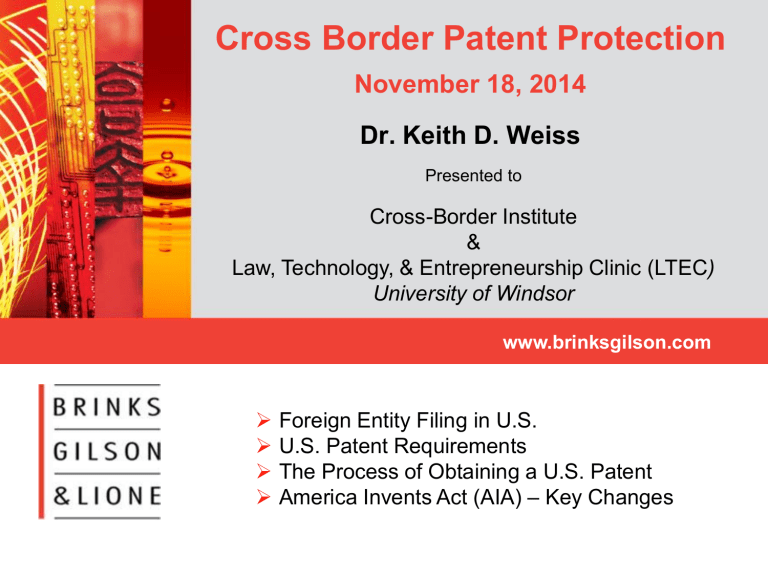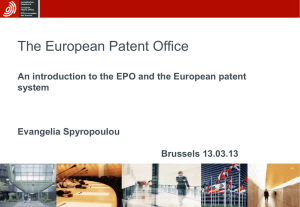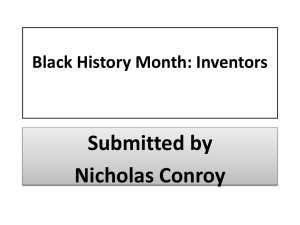Cross Border Patent Protection

Cross Border Patent Protection
November 18, 2014
Dr. Keith D. Weiss
Presented to
Cross-Border Institute
&
Law, Technology, & Entrepreneurship Clinic (LTEC )
University of Windsor www.brinksgilson.com
Foreign Entity Filing in U.S.
U.S. Patent Requirements
The Process of Obtaining a U.S. Patent
America Invents Act (AIA) – Key Changes
www.brinksgilson.com
Foreign Entity Filing in U.S.
176 Contracting Countries to Paris Convention
National Treatment
– each country will provide same protection to nationals of all contracting states that it provides to its own nationals
Right of Priority
– applicant may file application in any contracting state within 12 months of first national application and be given priority date of first national application
Common Rules
– (a) Patents that are issued are country specific
(b) Inventors have the right to be named
2
www.brinksgilson.com
Foreign Entity Filing in U.S.
148 Patent Cooperation Treaty (PCT) Member Countries (in Blue)
3
Foreign Entity Filing in U.S.
PCT Timeline
Start
www.brinksgilson.com
4
www.brinksgilson.com
Foreign Entity Filing in U.S.
35 U.S.C. § 371
National Stage
Commencement
Specification is same as international phase, change requires preliminary amendment
IDS only needed if PCT search results not submitted to USPTO
Certified copy of priority document only needed if not submitted to USPTO
Treated as the same application as the PCT
35 U.S.C.
§
363
"[a]n international application designating the United States shall have the effect, from its international filing date under article 11 of the treaty, of a national application for patent regularly filed in the Patent and Trademark Office....”
“ByPass” Continuation
Specification does not have to be the same, i.e. no preliminary amendment required
New IDS needed
Certified copy of priority document not required (*can submit copy and link from WIPO)
Treated as a new application
5
Foreign Entity Filing in U.S.
Summary of Benefits
Easier changes to specification/claims
New matter
No IDS
Provisional rights
Lower preparation costs
Delayed payment of fees
Total USPTO fees
Non-English language application
Reduced USPTO delays
Easier restriction practice
Patent Term Adjustment (PTA)
Accelerated Examination www.brinksgilson.com
371
✔
✔ *
Continuation
✔
✔
✔
✔
✔
✔
✔
✔
✔
✔
6
www.brinksgilson.com
A U.S. Patent Is…
UNITED STATES CONSTITUTION
Article I, Section 8, Clause 8
Congress Shall Have the Power …..
To promote the progress of science and useful arts, by securing for limited times to authors and inventors the exclusive right to their respective writings and discoveries;
A contract with the U.S. government.
Inventor discloses and describes the invention.
The U.S. government gives the inventor a 20 year right to exclude others from making, using, or offering the claimed invention for sale.
Does not provide permission to manufacture and sell.
Patent rights are for U.S. only.
U.S. Patent Act -- 35 USC Sections 1 - 376
A legal tool which permits the inventor or assignee to protect the investment of time, money, and resources expended in contributing to the advancement of technology for a period of time reasonable to realize a monetary return.
7
How
PATENTS
Create Value
www.brinksgilson.com
• Protects Product/Service
– Discourages competitors from entering market
–
Sue infringers
–
Creates licensing opportunities
• Builds Image as Technology Leader
Important to Seek Protection for Your Invention
8
www.brinksgilson.com
How are Patent Rights Protected?
Polaroid vs. Kodak
Polaroid sued Kodak for infringing on 12 patents protecting their instant photography products. The court ruled in Polaroid’s favor and stopped Kodak from making such cameras. Kodak’s losses included a cash settlement with Polaroid, the inability to provide film for 16M cameras already sold, and the rendering of $200M in plant equipment useless.
An inventor’s right to exclude others from practicing the invention is protected from infringement. A party whom makes, uses, or sells the invention without the consent of the inventor can be held liable to pay damages. If the infringing party continues to infringe upon an invention after being notified, they may be liable for triple damages and attorney fees.
A typical defense used in court is to have the patent or specific claims declared invalid due to prior art. A Federal District Court has jurisdiction to render a decision.
Obtaining a patent does not grant the right to make, use or sell the invention. The non-existence of dominating patents must be determined.
(Example: 3-legged stool vs. 4-legged chair)
9
www.brinksgilson.com
What is an Invention?
Statute (35 U.S.C. 101-103)
Any new, useful, and non-obvious process, device (+ improvements) or composition of matter, provided it is different from prior art of which you are aware. Except…..
1. Printed matter or arrangement
2. Scientific principle, equation, law of nature
3. Naturally occurring substance
4. Method of doing business
5. A mental process
Useful ( Utility ): You must demonstrate that the invention has an intended purpose
New ( Novelty ): The invention can not be known or used by others prior to submitting an application
NOTE: U.S. (only) allows 1 year leeway
Non-Obvious: The differences between the invention and prior
( Inventive Step ) art are great enough that the basic concept is not obvious to anyone of ordinary skill.
10
www.brinksgilson.com
Patent Requirements
1.
The statute defines things that the patent office considers prior art. Prior Art is a term used to describe existing knowledge found within the public domain in the form of ….
Issued patents
Published patent applications
Printed publications or articles
Products or items in public use or for sale
Duty of Candor
Anyone involved with a patent application (e.g., inventors, attorneys, etc.) must disclose to the patent office any pertinent prior art to which they are personally aware of.
2.
In the United States, an inventor’s own activities may not destroy novelty so long as a patent application is filed within one year of the activity ( 12-month grace period ).
3.
Many countries, however, have an absolute novelty requirement —there is no grace period. Thus, file application before public disclosure.
11
www.brinksgilson.com
Patent Requirements
Non-Obvious is a Subjective Judgment...
Factors Used to Evaluate Non-Obviousness
1.
The knowledge disclosed by prior art
(issued patents, published articles, existing products for use/sale, etc.)
2.
The differences that exist between the invention and the prior art
3.
Resolution of what should be considered ordinary skill
4.
Secondary considerations, e.g., commercial success of the invention
12
www.brinksgilson.com
Patent Requirements
Written Description and Enablement (35 U.S.C. § 112)
1.
“The specification shall contain a written description of the invention, and of the manner and process of making and using it, in such full, clear, concise, and exact terms as to enable any person skilled in the art to which it pertains, or with which it is most nearly connected, to make and use the same, and shall set forth the BEST MODE contemplated by the inventor of carrying out his invention.”
2.
Enablement requirement requires that the public knowledge is enriched by the specification commensurate in scope with the claims.
3.
The written description requirement is construed so that the claims do not cover more than that which the inventor described.
13
www.brinksgilson.com
Patent Requirements
Claims - Apparatus, Composition, Method (making or using)
i.
Claims are the legal “metes and bounds” defining a patent holder’s rights and what a patent holder can exclude someone else from doing during the term of the patent.
iii.
Claims define elements of the invention and their interrelationship to one another.
iv.
Claims include independent and dependent claims.
1.
An independent claim is necessarily broader in its scope than any claim that depends from the independent claim. (Think of a genus.)
2.
Dependent claims depend from other dependent claims or an independent claim. (Think of a subgenus or species.) v.
Each claim stands on its own for purposes of assessing patentability, enforceability, and infringement.
14
www.brinksgilson.com
The Patenting Process
Protect the Invention Before the Patent Application is Filed …
Do not publish invention in any public forum (either as a written document or presented as a seminar)
Do not offer invention for sale
Properly use a Confidentiality Agreement with potential customers. Document the relationship and any sample testing as EXPERIMENTAL . (“This will avoid any secret offer for sale”)
Label all samples and documents as Confidential
15
www.brinksgilson.com
The Patenting Process
What Happens After a Patent Application is Submitted?
(1) A patent examiner is assigned from an appropriate technical area
(2) Examiner conducts a search for existence of prior art
(3) Examiner may reject invention in part or whole as being similar to and/or obvious; Examiner may also reject due to unclear invention description
(4) Applicant/Attorney files a formal response to Examiner’s action;
A reduction in scope of the claims may result
(5) Steps (3) and (4) repeat until a decision is reached or a final rejection is received
(6) Either a PATENT ISSUES or a decision is made to file a continuation or an appeal to the Patent Appeal Board
16
www.brinksgilson.com
American Invents Act (AIA)
First-Inventor-to-File
Prior to passage of the American Invents Act (AIA), the
U.S. employed a “First to Invent” system.
The AIA changed that standard to a first-inventor-to-file system on March 16, 2013.
Not a true “first-to-file” system
- Named inventor must be a true inventor; filing by a non-inventor is still prohibited.
The application with earlier “
effective filing date
” prevails.
17
www.brinksgilson.com
American Invents Act (AIA)
Effective Filing Date
Actual filing date of the patent or application for patent
OR
Earliest claimed priority date
Paris Convention priority
PCT practice
U.S. continuation and divisional practice
18
www.brinksgilson.com
AIA – Inter Partes Review (IPR)
Created by AIA, effective September 16, 2012 (but applicable to all patents)
Replaces Inter Partes Reexamination
Tribunal is the Patent Trial and Appeal Board (PTAB) in USPTO
Who can request? Anyone not the patent owner (must identify real party in interest)
What is the basis? Prior art under Sections 102 and 103 consisting of patents or printed publications
What is the standard to initiate? “A reasonable likelihood ” of invalidity of at least one challenged claim
Claims are given their “broadest reasonable construction in light of the specification”
What is the cost? A request fee of $9,000 (partially refunded if IPR not ordered), and $14,000 if a review is instituted
Who participates? Once an IPR is initiated, both the patent owner and the requester participate
19
www.brinksgilson.com
AIA – Inter Partes Review
(cont.)
When can IPR be requested? Anytime, except:
Not within nine months of grant or until a PGR has concluded
Not if petitioner has filed a civil action challenging validity of a claim of the patent
Not if petitioner was sued for infringement of the patent more than one year before
How long can an IPR last? One year by statute, with a 6-month extension for “good cause”
What is the petitioner’s burden of proof? Must prove unpatentability by a preponderance of the evidence
Is there estoppel? Yes, if the IPR results in a final decision
As to any ground raised or that reasonably could have been raised
On claim-by-claim basis
In the USPTO, a civil action, and the ITC
20
www.brinksgilson.com
AIA – Inter Partes Review
(cont.)
Discovery is available but limited
No “fishing expeditions”
A protective order is available to protect confidential information
Claim amendments by the patent owner are limited
One motion to cancel a challenged claim and/or propose a reasonable number of substitute claims
Claims cannot be broadened
Intervening rights available for amended claims
Settlement is possible between the patent owner and a requester
In writing and filed with the USPTO
No estoppel applies
Appeal of a final PTAB decision is to the Court of Appeals for the
Federal Circuit (CAFC)
21
www.brinksgilson.com
AIA – Inter Partes Review
(cont.)
Benefits:
Compared to a patent litigation in federal court, IPR is:
Faster (12-18 months versus years)
Less expensive ($100,000-300,000 versus 10X that, or more)
Focused on validity
Handled by a tribunal experienced with patents and technology
(versus a judge or jury)
No presumption of validity (prove invalidity by preponderance of evidence versus clear and convincing evidence)
Claims given “broadest reasonable construction” versus interpretation by one skilled in the art
Disadvantages:
More costly than ex parte reexamination
Estoppel applies (but estoppel also applies in litigation)
Much more limited discovery than in litigation 22
www.brinksgilson.com
AIA - Post-Grant Review (PGR)
Created by AIA, effective September 16, 2012 (but only applies to patents with an effective filing date of March 15, 2013 or later)
Tribunal is the PTAB
Who can request? Anyone not the patent owner (must identify real party in interest)
What is the basis? Any ground of invalidity under:
Section 101 (patentable subject matter)
Section 102, 103 (prior art)
Section 112 (enablement, written description - - but not best mode)
“A novel or unsettled legal question that is important to other patents or patent applications”
What is the cost? A request fee of $12,000, plus $18,000 if a review is instituted
23
www.brinksgilson.com
AIA - Post-Grant Review (cont.)
When can a PGR petition be filed? Only within nine months of patent issuance , except:
Not if petitioner has filed a civil action challenging validity of a claim of the patent
What is the standard to initiate? Invalidity of at least one challenged claim is “more likely than not”
Like IPR, claims are given their “broadest reasonable construction in light of the specification”
Is there estoppel? Yes, if the PGR results in a final decision
As to any ground raised or that reasonably could have been raised
On claim-by-claim basis
In the USPTO, a civil action, and the ITC
24
www.brinksgilson.com
AIA - Post-Grant Review
(cont.)
Like an IPR, a PGR:
Must conclude within one year (with a 6-month extension possible for “good cause”)
Imposes a burden of proving invalidity by a preponderance of the evidence
Allows both the patent owner and the requester to participate
Allows limited discovery
Allows the patent owner to make a motion to cancel any challenged claim and/or add a reasonable number of (not broader) substitute claims
Provides intervening rights for amended or new claims
Allows for settlement
May be appealed to the CAFC
25
www.brinksgilson.com
AIA - Post-Grant Review
(cont.)
Benefits:
Generally the same as for IPR, but more invalidity grounds may be asserted
Can track competitors’ patent applications and “oppose” dangerous patents when they issue
Disadvantages:
Generally the same as for IPR, but estoppel is broader (because more invalidity grounds are available)
Limited window of time to request (9 months)
26
www.brinksgilson.com
27







